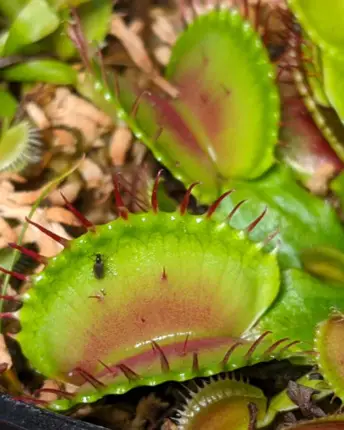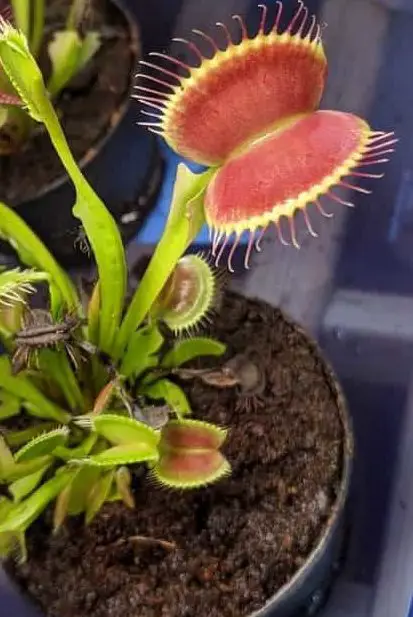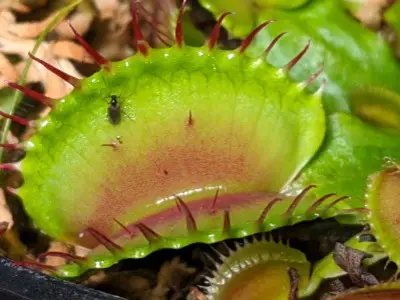Venus fly traps are known for trapping insects with their leaves. They possess a mechanism to close their leaves and capture prey that provides vital nutrients. In this article, you will learn why Venus flytraps won’t work, meaning why they do not close their leaves.
Venus fly traps won’t close their leaves because they are either dormant, sick, or their leaves are exhausted. Dormancy is a natural process that does not affect the plant’s health. However, the leaves not closing can be a sign of poor health.
I have grown carnivorous plants for over five years and Venus fly traps for the same time. Here is a quick summary of possible causes for your plant not to close; keep reading to go step by step to figure out why your plant is not working and how to fix it.
| Dormancy: the plant is dormant. | Venus fly traps go into a hibernation stage during the cold winter months. When Venus fly traps go dormant, their traps often stop working altogether. |
| The leaf is exhausted. | Each leaf in a Venus flytrap can only open and close a limited number of times. After the leaf has closed a limited amount of times, it will stop working. |
| The Venus Flytrap is sick. | When venus fly traps are experiencing some type of distress, like incorrect growing conditions, they will adapt to preserve energy. In those cases, their traps might stop working as their main focus is not capturing bugs, but surviving. |
First, let’s start by learning how Venus Fly traps work and what you must do for the leaves to close.
How Venus Fly Trap Work and Close Their Traps
In the wild, Venus fly traps attract bugs with their bright colors and the sweet nectar they secrete in their traps. Once an insect has arrived at the trap, it just needs to trigger the trap to close.
Each trap is made up of two lobes. In the interior part of the lobes, you will find three trigger hairs in each. They are thin filaments. When in contact with a certain amount of movement, the trap closes.

If a bug or you stimulate the trigger hairs inside the trap by touching them twice within a short period (usually 5 seconds), the plant closes. You need to touch the trigger hairs twice in a row. There is no need to touch all the trigger hairs; just one should be enough to activate the trap.
Venus flytraps employ large amounts of energy, activating their traps. The double stimuli mechanism is critical to saving the plant’s energy and livelihood. Each leaf requires two consecutive stimuli to close.
After the appropriate stimuli, a trap closes in a snap of a second, hopefully (for the plant) capturing the victim. The lobes come together while the cilia in intertwined, but the leaf if not wholly shut at first. The traps close in two stages…
First, the lobes come together, but they do not close completely. At this point, the plant is waiting for further stimuli: movement within its semi-closed trap. Without further stimuli, the plant reopens after a few minutes/hours.
If the trap receives further stimuli, the trap closes completely and starts digesting the insects.
The Venus Fly Trap Is Dormant
Venus flytraps go dormant during the winter months. Dormancy is a period of inactivity when the plant rest and recovers. it is very similar to hibernation.
When venus fly traps are dormant, their traps often stop working. Since the plant is inactive, it does not have any interest in capturing prey.
A venus fly trap not working due to dormancy is completely normal and shouldn’t be a concern.
How do you know f your Venus fly trap is dormant?
Venus fly traps go dormant in the winter after exposure to temperatures under 45 F (7 C) for two to three weeks. Once venus fly traps enter dormancy, they usually lose some leaves and start looking down.
The Easiest Fix: No fixes are needed; just make sure your plant experiences dormancy every year
Dormancy is not a concern; it is actually a very normal process that is needed for the plant’s health. Venus fly traps must go dormant every year to stay healthy. If your plant is dormant or you need to learn more about the process, read this article on Venus fly trap dormancy and care during dormancy.
The Trap Is Exhausted and Dying
Each Venus fly trap will grow multiple traps, usually 5 to 7 traps. Each of those traps has a limited capacity for opening and closing. Once the trap has reached its limit, it will stop working.
This can be a concern in some cases, while in others, it is a completely normal process. Let me explain…
Leaves will become exhausted naturally if they are triggered multiple times by insects, the wind, or even a human plating with the traps. It is common that when Venus fly traps are shipped in the mail, their traps are closed, and they might reopen but never close again. Due to the stress of the trip, the traps might have closed multiple times and become exhausted.
If you notice one or two traps are exhausted, and they won’t close, but the other traps are working fine. You shouldn’t worry. Your plant is not sick, but only a couple of leaves are exhausted. After they stop working, they will likely turn black. Don’t worry; they are just withering. After they dry up, new growth will be spurring too.
Sometimes leaves wither due to their natural lifecycle, but in other cases it is 100% preventable. Here is a complete list of the most common causes for black leaves plus prevention.

The leaf in this picture is fully opened outwards. When leaves look like this, it is a sign they are exhausted. It is an older leaf that has just closed enough times.
younger traps that are ready to close will have the lobes closer together.
The main issue arises if none of the traps are working and the plant is not dormant. In that scenario, I recommend reading the next section. Your Venus fly trap might be unhealthy.
Easy Fix: Avoid stress and triggering traps
Venus fly traps spend substantial amounts of energy controlling their traps. trigger the traps for no reason will cause a lot of stress and stress the traps. Avoid triggering the traps with your fingers to save your plant’s energy.
Also, try to avoid exhausting any type of stress that could trigger the traps without benefits. For example, your pet might be playing with the plant, or a curtain might be touching and triggering the plant.
Activating the leaves won’t kill the plant but will eventually make the leaves turn black. Doing this constantly can pose a significant burden to your carnivorous plant.
Your Venus Fly Trap Is Unhealthy
When venus fly traps are unhealthy, they start to suffer greatly. In some cases, they might become deformed, lose their colors, and their traps can stop working altogether. To grow healthy leaves again you can follow these instructions.. To grow healthy leaves again you can follow these instructions.. If you notice your plant is not working and it is looking down, make sure you check your plant’s health.
Unhealthy Venus fly traps are not interested in capturing bugs. Venus fly traps extract most of their energy from the sun through photosynthesis. Capturing insects is just a supplement. When the plant is in distress, it deprioritizes capturing insects.
Here is a list of common mistakes made when growing Venus fly traps. Do not worry if you have made one or multiple; there is a fix for all 😉
- The soil is not carnivorous soil and it is poisoning your plant
- The water you use is not mineral free
- The plant needs more light
- The venus flytrap has too much or too light water
- The feeding is out of control
- Extreme heat exposure
- Too much stress
- The fertilizer is unsuitable
- Your plant is not eating any bugs
- There is a pest infestation
- The Venus fly trap is suffering from root rot
This one of my articles covers all these growing mistakes and how to fix them: Common reasons Your Venus Fly Trap Is Unhealthy + Fixes.
The Fix: Adjust the environment of your plant
Go over the care instructions below and find the reason(s) why your plant might be struggling. Adjust the conditions as needed to bring your plant back to health. After your plant recovers, it will start looking healthier (brighter colors, larger leaves), and the traps should start working again.
- Light: Partial or direct sunlight for at least six hours a day. Not enough light will affect the traps and eventually kill the plant.
- Water type: Only water with pure water: rainwater, distilled water, or reverse osmosis water. If you used the incorrect water type, consider changing the soil as it might have mineral build-up.
- Watering frequency: Water frequently to keep the soil moist at all times but not saturated
- Soil: Only employ nutrient-free soil. Pure sphagnum moss or peat moss are viable options. Using the incorrect soil is very risk; swap the soil if you make a mistake.
- Feeding: Venus flytraps do not need bugs to survive, but access to feed promotes their growth.
- Pot Dimensions: Choose pots that match the size of the plant: 2 inches – 6 inches in diameter. And always employ deep pots (7 inches)
- Pot Materials: The best-suited materials are plastic, Styrofoam, and glazed ceramic.
- Repotting: For best result, repot Venus flytraps once a year (here is a guide on how to pot your plants)
- Trimming: Remove black leaves by cutting them from the base with scissors.
- Temperature: Venus flytraps can withstand high temperatures of up to 95 F and cold temperatures close to freezing
- Humidity: Venus flytraps can adapt to arid climates, but they benefit from high-humidity environments.
- Fertilizers: There is no need to fertilize Venus flytraps.
- Dormancy: Venus flytraps go dormant during the winter for 2-3 months.
- Terrariums: Venus flytraps can grow in a terrarium. However, close terrariums limit their access to insects and their exposure to suitable temperatures for dormancy which can end up harming your plant.
Feeding a Venus Fly Trap
Now that the traps in your plant are working again, you can think about feeding bugs to it.
When feeding a Venus flytrap, employ bugs that can fit inside a single leaf and drop the insect in between the trap’s lobes. If the insect touches the trigger hairs twice in a row the trap will close capturing the prey.
Venus flytraps growing outdoors often capture their own food, whereas Venus flytraps growing indoors often struggle to capture bugs. It is not a requirement to feed your plant as the nutrients extracted from bugs are just an extra boost.
Still, it is a fun process and it is a way to promote growth. The feeding process is not too hard, but you must follow the instructions below to avoid harming your plant.
Here is a list of best practices when feeding Venus fly trap. You can view the full instructions with pictures herein this article: Venus Fly Trap feeding Guide.
- Outdoor Venus flytraps do not require feeding
- Feed your plant once every 2 to 6 weeks
- Only feed insects or spiders to your Venus Flytrap
- The insects must fit inside the trap
- Do not feed your plant during dormancy
- Baby Venus flytraps do not need to be fed
Recommended Products for Growing Venus Flytraps
- Carnivorous Plant Soil
- Carnivorous plant soil: https://amzn.to/3uVbg39
- Artificial Lighting
- Small plant light for 1-2 plants: https://amzn.to/2RsGlxr
- T8 LED light fixture for multiple plants (6500k Cool White): https://amzn.to/3uWoeh2
- Pots and Miscellaneus
- Nursery pots for single plants: https://amzn.to/34Q6byu
- TDS meter to measure water quality: https://amzn.to/3g8VKLI
- Dried crickets to feed carnivorous plants: https://amzn.to/34QEnKv


